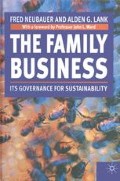Abstract
One of the first tasks to confront the serious student of family business, or as some prefer it, ‘family enterprise’, as a field of scholarly inquiry, is to determine what is meant by the term. Researchers from academia and consulting organisations are not the only ones grappling with the definition. Based on the authors’ numerous conversations with journalists pursuing some hot story involving conflict between members of a family who are in business together, the question is often posed: ‘Tell me, what is a family business really?’ Turning to owning families for help, unfortunately, is not particularly fruitful. The authors have served for several years on the faculty of the International Institute for Management Development’s Leading the Family Business (LFB) programme. The marketing of LFB makes it quite clear that the workshop is only intended (with very few exceptions) for those who presently lead (or own) or who will lead (or own) their own family’s enterprise. The opening question at LFB has traditionally been: ‘What does the term ‘family business or enterprise’ mean to you?’ The range of responses is large and idiosyncratic to the point that some participants wonder whether or not their newly met colleagues are unwelcome interlopers!
You are a King by your own Fireside, as much as any Monarch on his Throne.
(Miguel de Cervantes, Don Quixote de la Mancha, 1547–1616)
Access this chapter
Tax calculation will be finalised at checkout
Purchases are for personal use only
Preview
Unable to display preview. Download preview PDF.
Notes
R. G. Donnelly, ‘The Family Business’, Harvard Business Review, vol. 42, No. 4, (July–August 1964), p. 94.
M.C. Shanker and J.H. Astrachan, ‘Myths and Realities: Family Businesses’ Contribution to the US Economy — A Framework for Assessing Family Business Statistics’, Family Business Review, vol. 9, no. 2 (Summer 1996), pp. 107–24.
D. Leach and J. Leahy, ‘Ownership Structures, Control and the Performance of Large British Companies’, Economic Journal, vol. 101 (1991), p. 1435.
D. Junge, ‘The Pitcairns’, Proceedings of the 5th FBN Conference Family Businss Network, Lausanne, 1995, p. 171.
A. J. Haahti (ed.), Interstratos (Internationalization of Strategic Orientations of European Small and Medium Enterprises), Brussels: European Institute for Advanced Studies in Management, 1994.
Happily there is also evidence that a restricted number of mostly medium-size companies have been able to dominate particular market niches on a world-wide basis. See H. Simon, Hidden Champions: Lessons from 500 of the World’s Best Unknown Companies, Boston: Harvard Business School Press, 1996, for a fascinating series of success stories.
K. Graham, Personal History, New York: Alfred A. Knopf, 1997, p. 619.
R. Church, ‘The Family Firm in Industrial Capitalism: International Perspectives on Hypotheses and History’, in C. E. Aronoff, J. H. Astrachan and J. L. Ward (eds), Family Business Sourcebook II, Marietta, Georgia: Business Owner Resources, 1996, p. 559.
Cited in M.H. Morris, R.W. Williams and D. Nel, ‘Factors Influencing Family Business Succession’, International Journal of Entrepreneurial Behaviour & Research, vol. 2, no. 3 (1996), p. 68. Using ‘emotional kinship group’ as the key descriptor points out the pitfalls of trying to be too exhaustive. Such a designation would include elite military units such as the US Marine Corps, which most students of the field find a bit removed from the concept of a family enterprise.
B. Barry, ‘The Development of Organization Structure in the Family Firm’, Family Business Review, vol. II, no. 3 (Fall 1989), p. 257.
I. Lansberg, E. L. Perrow and S. Rogolski, ‘Family Business as an Emerging Field’, Family Business Review, vol. I, no. 1 (Spring 1988), p. 2.
Cited in W. C. Handler, ‘Methodological Issues and Considerations in Studying Family Businesses’, Family Business Review, vol. II, no. 3 (Fall 1989), p. 257.
M.A. Gallo and J. Sveen, ‘Internationalizing the Family Business: Facilitating and Restraining Forces’, Family Business Review, vol. IV, no. 2 (Summer 1991), p. 181. As is not uncommon, in subsequent research Gallo (with M.J. Estapé) changed the definition to encompass one or two families if they hold more than 10 per cent of the shares and if the joint share of the three next largest shareholders is no greater than one third of the shares held by the one or two dominating families. This definition is unique.
R. Donckels and E. Fröhlich, ‘Are Family Businesses Really Different? European Experiences from STRATOS’, Family Business Review, vol. IV, no. 2 (Summer 1991), p. 149.
D.T. Jaffee, ‘Working with the Ones You Love’, Emeryville, CA: Conari Press 1991 p. 27.
D. Bork, Family Business, Risky Business, New York: Amacon, 1986, p. 24.
P. C. Rosenblatt, L. de Mik, R. M. Anderson and P. A. Johnson, The Family in Business: Understanding and Dealing with the Challenges Entrepreneurial Families Face, San Francisco: Jossey-Bass, 1985, pp. 4–5.
R. A. Litz, ‘The Family Business: Toward Definitional Clarity’, Family Business Review, vol. VIII, no. 2 (Summer 1995), p. 78. Note that as the last part of his definition relates to intentions, a simple four-cell matrix is established; PNFB, potential non-family business; FB, family business; NFB, non-family business; PFB, potential family business.
Copyright information
© 1998 Fred Neubauer and Alden G. Lank
About this chapter
Cite this chapter
Neubauer, F., Lank, A.G. (1998). Nature and Significance of Family Business. In: The Family Business. Palgrave Macmillan, London. https://doi.org/10.1007/978-1-349-14465-5_1
Download citation
DOI: https://doi.org/10.1007/978-1-349-14465-5_1
Publisher Name: Palgrave Macmillan, London
Print ISBN: 978-1-349-14467-9
Online ISBN: 978-1-349-14465-5
eBook Packages: Palgrave Business & Management CollectionBusiness and Management (R0)

